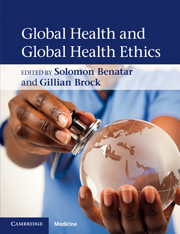Book contents
- Frontmatter
- Contents
- List of contributors
- Introduction
- Section 1 Global health, definitions and descriptions
- 1 What is global health?
- 2 The state of global health in a radically unequal world: patterns and prospects
- 3 Addressing the societal determinants of health: the key global health ethics imperative of our times
- 4 Gender and global health: inequality and differences
- 5 Health systems and health
- Section 2 Global health ethics, responsibilities and justice: some central issues
- Section 3 Analyzing some reasons for poor health
- Section 4 Shaping the future
- Index
- References
3 - Addressing the societal determinants of health: the key global health ethics imperative of our times
Published online by Cambridge University Press: 01 March 2011
- Frontmatter
- Contents
- List of contributors
- Introduction
- Section 1 Global health, definitions and descriptions
- 1 What is global health?
- 2 The state of global health in a radically unequal world: patterns and prospects
- 3 Addressing the societal determinants of health: the key global health ethics imperative of our times
- 4 Gender and global health: inequality and differences
- 5 Health systems and health
- Section 2 Global health ethics, responsibilities and justice: some central issues
- Section 3 Analyzing some reasons for poor health
- Section 4 Shaping the future
- Index
- References
Summary
If the rich could hire others to die for them, we, the poor, would all make a nice living.
– Mordcha, the innkeeper, Fiddler on the RoofIn 2006, Costa Ricans and Cubans had a life expectancy of 78, identical to that of the USA. Yet the US per capita GDP was almost five times that of Costa Rica and almost ten times Cuba's. Moreover, the US outstripped total health spending in Costa Rica and Cuba by a factor of 9 and 19, respectively (WHOSIS, 2009). Even more striking, in 2000, inhabitants of the southern Indian state of Kerala, earning, on average, less than US$3000 per year, had a life expectancy of 74.6 (Government of Kerala, 2005), while Washington, DC residents, with almost $30,000 per capita annual income, had a life expectancy of 72.6 years (Phillips & Beasley, 2005; US Government, 2005). Why are Costa Ricans, Cubans and Keralites so healthy, and why does US wealth not enable greater longevity? The answer to this question has far less to do with the nature of the people living in these settings or of their disease and epidemiological profile than with the structure of their societies.
A political economy approach to health (see Figure 3.1 and Gill and Bakker, Chapter 19, this volume) examines the role of the distribution of power and of political, economic and social resources in shaping the health of populations, showing that factors such as genetic endowment, human behavior and medical care explain only a small fraction of health and disease and of patterns of inequalities in health.
- Type
- Chapter
- Information
- Global Health and Global Health Ethics , pp. 37 - 52Publisher: Cambridge University PressPrint publication year: 2011
References
- 11
- Cited by



